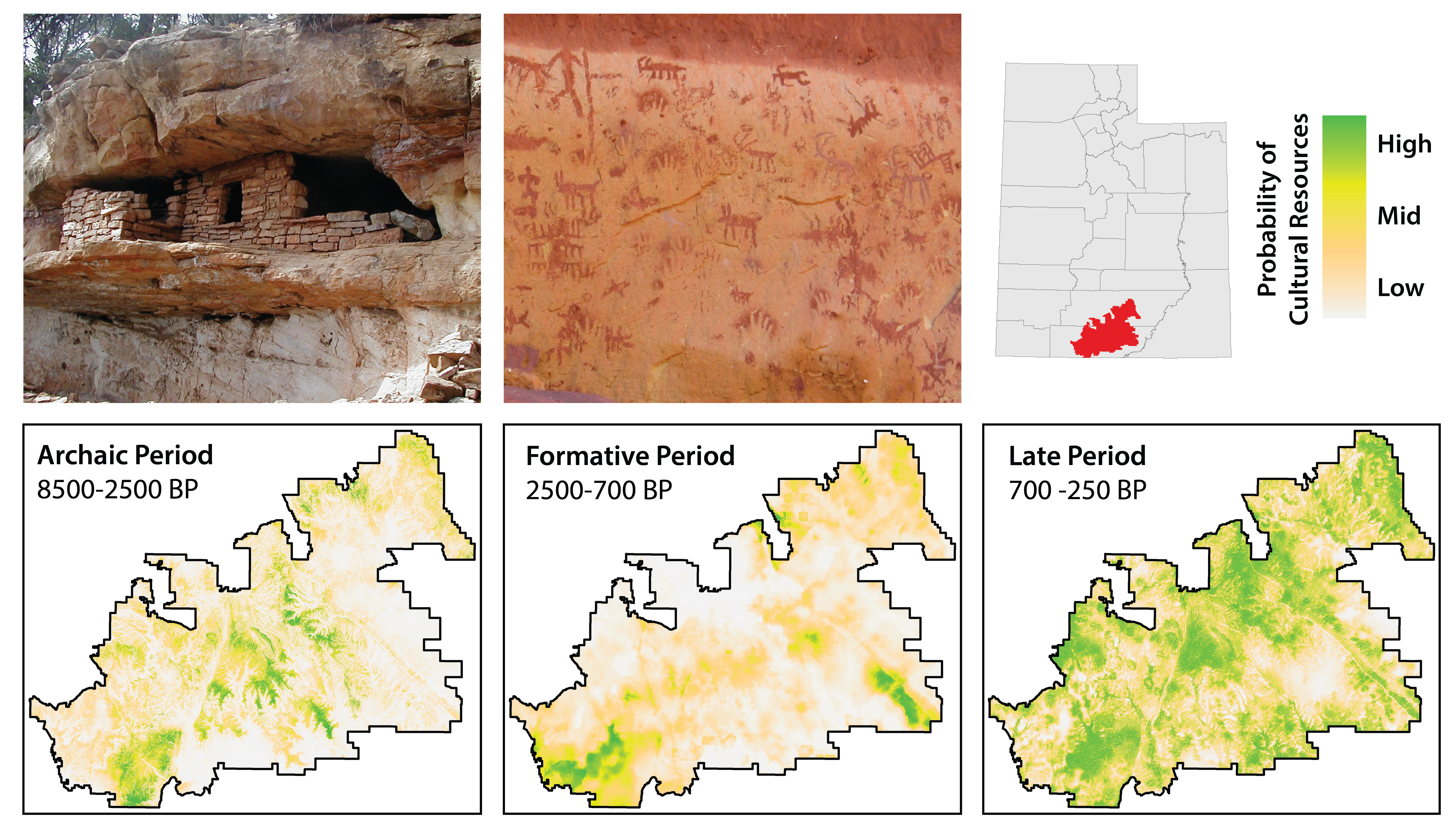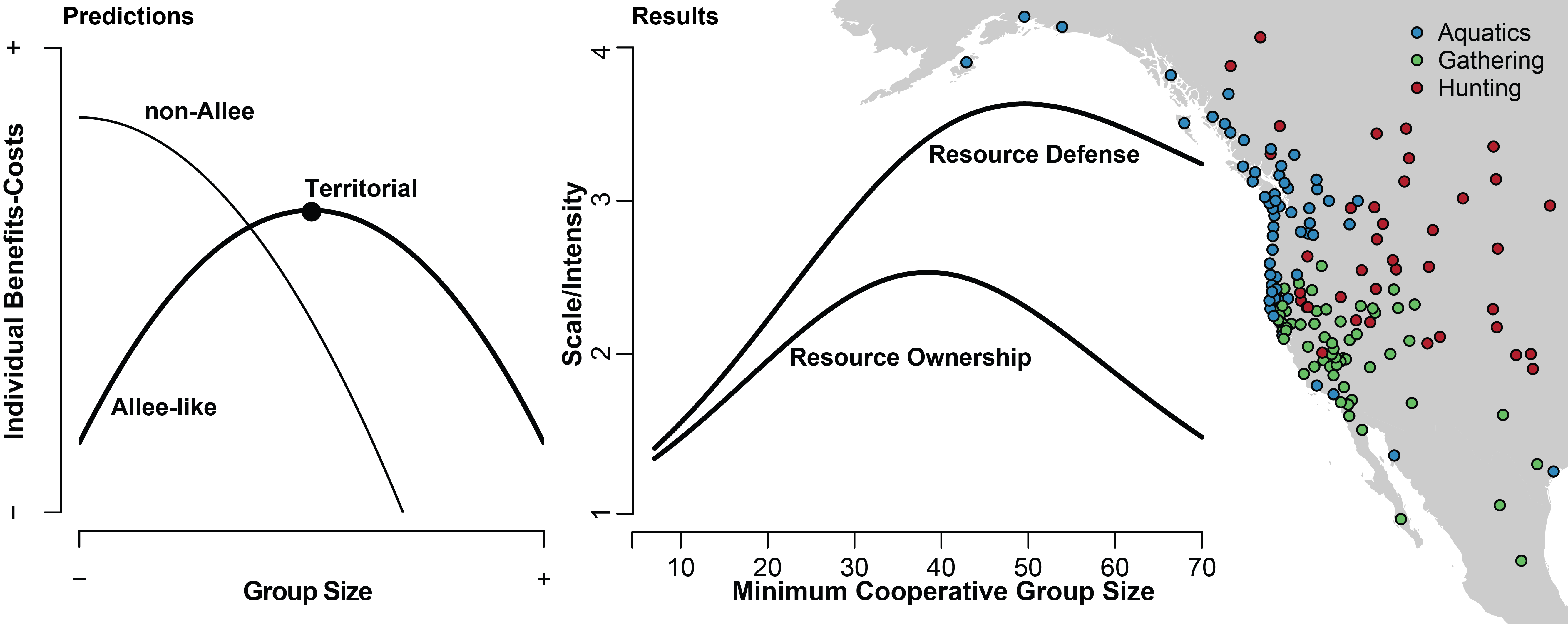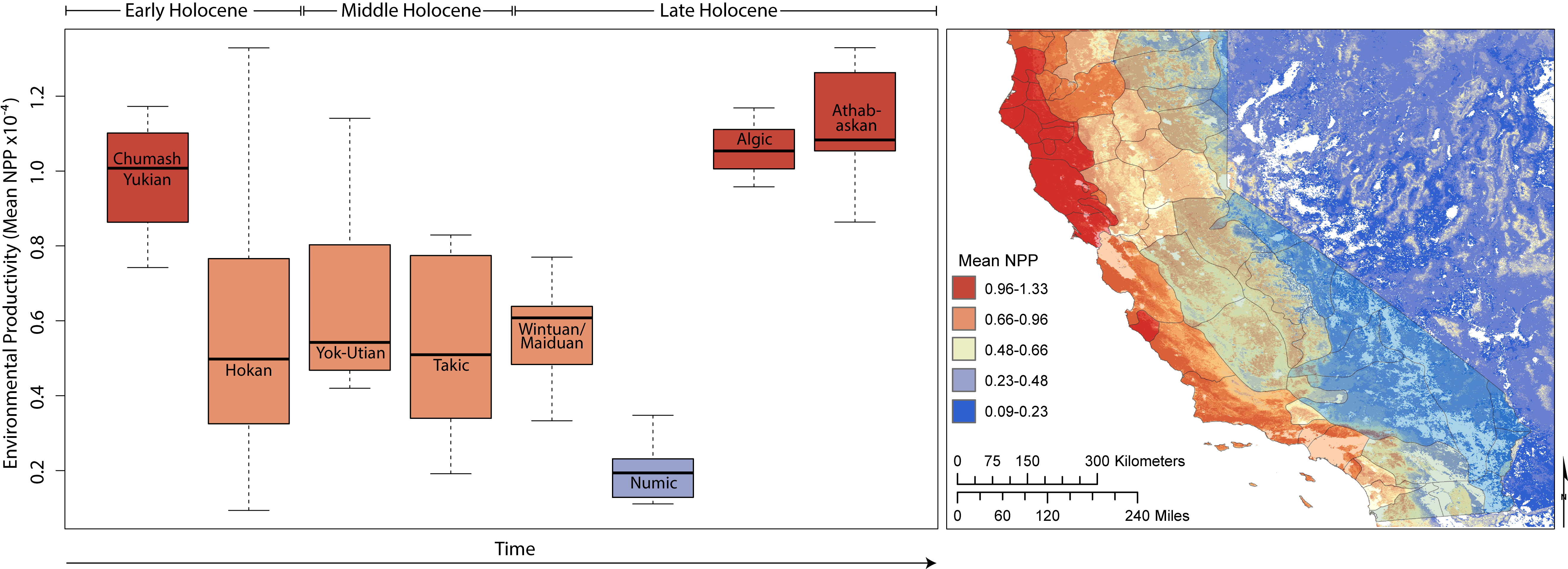Research Summaries

Recent NSF-funded research projects focus on Restoring Indigenous Socioenvironmental Systems (RISES) in the Bear River Basin and understanding the Dynamic Impacts of Environmental Change and Biomass Harvesting on Woodland Ecosystems and Traditional Livelihoods in Southern Utah. More research summaries are available below.
Climate Change Impacts Indigenous Energy Sovereignty
Ninety percent of Diné (Navajo) households in Utah rely on firewood from federal or Tribal land for home heating and cooking. While this practice had endured for centuries, woodlands are under threat from climate change. Indigenous energy sovereignty and woodland health are possible in the future if greenhouse gas emissions are reduced, household demand stays steady or decreases, and harvesting strategies follow traditional ecological knowledge.

For more, see Magargal, Kate, Kurt Wilson, Shaniah Chee, Michael J. Campbell, Vanessa Bailey, Philip E. Dennison, William RL Anderegg, Adrienne Cachelin, Simon Brewer, and Brian F. Codding (2023) The impacts of climate change, energy policy and traditional ecological practices on future firewood availability for Diné (Navajo) People. Philosophical Transactions of the Royal Society B 378(1889): 20220394. DOI: 10.1098/rstb.2022.0394. and Magargal, Kate, Jonah Yellowman, Shaniah Chee, Molly Wabel, Shane Macfarlan, and Brian F. Codding (2023) Firewood and Energy Sovereignty on Navajo Nation. Human Ecology 51: 497-511. DOI: 10.1007/s10745-023-00411-2.
Ecological Dynamics Influence Social (In)equality
The unequal distribution of wealth and power is a major problem today, and has a deep history in our lineage. Yet the causes of inequality remain debated. Comparisons across human and non-human societies suggest some common and disparate patterns, which helps explain the origins of inequality and how to improve our collective future.

For more, see the special issue in Philosophical Transactions of the Royal Society, B. compiled and edited by Eric Alden Smith, Jennifer Elaine Smith and Brian F. Codding available here. This issue includes the paper Wilson, Kurt M., Kasey E. Cole, and Brian F. Codding (2023) Identifying key socioecological factors influencing the expression of egalitarianism and inequality among foragers. Philosophical Transactions of the Royal Society B. 378(1883):20220311. DOI:10.1098/rstb.2022.0311.
Demographic Pressure Encourages Adoption of Farming
The spread of agriculture is a major driver of social and environmental change, yet farming is less profitable than foraging, so why would individuals choose to adopt agriculture? Results suggest population competition encouraged the adoption of farming first on the Colorado Plateau and subsequently in the Great Basin as individuals began cultivating maize in order to make a living.

For more, see Codding, Brian F., Joan Brenner Coltrain, Lisbeth Louderback, Kenneth Blake Vernon, Kate E. Magargal, Peter M. Yaworsky, Erick Robinson, Simon C. Brewer, and Jerry D. Spangler (2022) Socioecological dynamics structuring the spread of farming in the North American Basin-Plateau Region. Environmental Archaeology 27(4): 434-446. DOI: 10.1080/14614103.2021.1927480 (link to pdf). Also see Weitzel, Elic M., and Brian F. Codding (2022) The ideal distribution model and archaeological settlement patterning. Environmental Archaeology 27(4): 349-356. DOI: 10.1080/14614103.2020.1803015.
Indigenous Subsistence Strategies Leave Enduring Ecological Legacies
Rare edible and medicinal plant species are more numerous at more complex archaeological sites in the Bears Ears region, Utah, indicating a legacy of past human behavior that persists today. Managing these coupled archaeological sites and ecosystems will require co-management with federal agencies and Tribes.

For more, see Pavlik, Bruce M., Lisbeth A. Louderback, Kenneth B. Vernon, Peter M. Yaworsky, Cynthia Wilson, Arnold Clifford, and Brian F. Codding (2021) Plant species richness at archaeological sites suggests ecological legacy of Indigenous subsistence on the Colorado Plateau. Proceedings of the National Academy of Sciences 118 (21) e2025047118. DOI: 10.1073/pnas.2025047118. Also see the press release, and coverage in the Salt Lake Tribune.
Indigenous Land Use Overrode Climate to Influence Wildfires
Sedimentary records from Fish Lake, Utah reveal a peak in fire activity from about 1000 to 500 years ago that correlates with past human population density, not local droughts, suggesting that humans influenced past fire regimes. Post-Colonial fire regimes are catastrophic due in part to the removal of Indigenous land use practices.

For more, see: Carter, Vachel A., Andrea Brunelle, Mitchell J. Power, R. Justin DeRose, Matthew F. Bekker, Isaac Hart, Simon Brewer, Jerry Spangler, Erick Robinson, Mark Abbott, S. Yoshi Maezumi, and Brian F. Codding (2021) Legacies of Indigenous land use shaped past wildfire regimes in the Basin-Plateau Region, USA. Communications Earth & Environment 2, 72. DOI: 10.1038/s43247-021-00137-3 Also see the press release, Nature behind the paper, and brief on NPR Utah | KUER.
Climatic and Anthropogenic Change Drove Species Extinction
The extinction of California’s flightless marine duck coincides with an increasingly variable climate and growing human populations. These findings reveal a previously unknown ecological baseline that was transformed by both climate and hunting. The duck’s demise opened up an ecological niche for the iconic sea otter, resulting in the nearshore marine ecosystems we know today.

For more, see Jones, Terry L., Joan Brenner Coltrain, David K. Jacobs, Judith Porcasi, Simon C. Brewer, Janet C. Buckner, John D. Perrine, and Brian F. Codding (2021) Causes and consequences of the late Holocene extinction of the marine flightless duck (Chendytes lawi) in the northeastern Pacific. Quaternary Science Reviews, 260, p.106914. DOI: 10.1016/j.quascirev.2021.106914 Also see Broughton, Jack M., Brian F. Codding, John Tyler Faith, Kathryn A. Mohlenhoff, Ruth Gruhn, Joan Brenner-Coltrain, and Isaac Hart (2022) El Niño frequency threshold controls coastal biotic communities. Science, 377(6611), 1202-1205. DOI: 10.1126/science.abm1033 and associated commentary.
Monopolizable Resource Use Allows for Emergence of Hierarchy
Higher reliance on and ownership of clumped aquatic (primarily salmon) resources is associated with greater political-economic inequality, suggesting that institutionalized hierarchy can arise in egalitarian systems when individuals rely on defensible clumped resources that can be monopolized.

For more, see Smith, Eric Alden, and Brian F. Codding (2021) Ecological Variation and Institutionalized Inequality in Hunter-Gatherer Societies. Proceedings of the National Academy of Sciences 118 (13) e2016134118. DOI: 10.1073/pnas.2016134118.
Past Indigenous Land Use Informs Cultural Resource Conservation
Past land use decisions on what is now the Grand Staircase-Escalante National Monument vary through time depending on whether people were foraging or farming. This has important implications for understanding past settlement behavior, and, for informing policy aimed at conserving these remarkable archaeological resources today.

For more, see: Yaworsky, Peter M., Vernon, Kenneth Blake, Spangler, Jerry D., Brewer, Simon C., and Codding, Brian F. (2020). Advancing predictive modeling in archaeology: An evaluation of regression and machine learning methods on the Grand Staircase-Escalante National Monument. PloS One, 15(10), e0239424. DOI: 10.1371/journal.pone.0239424. Also see Vernon, Kenneth Blake, Yaworsky, Peter M., Spangler, Jerry., Brewer, Simon, and Codding, Brian F. (2022). Decomposing Habitat Suitability Across the Forager to Farmer Transition. Environmental Archaeology, 27: 420-433. DOI: 10.1080/14614103.2020.1746880. Also see our public poster.
Environmental Inequality may lead to Social Inequality
A global analysis reveals that societies are more likely to have internal differentiation in wealth and power when natural resources are unevenly distributed across space (i.e., when environments are heterogeneous), which helps elucidate factors that lead to the emergence and persistence of social inequality.

For more, see Wilson, Kurt M., and Brian F. Codding (2020). The Marginal Utility of Inequality: A Global Examination across Ethnographic Societies. Human Nature 31:361–386. DOI: 10.1007/s12110-020-09383-4.
Cooperation Influences Territoriality
Variation in territorial behavior, including resource ownership and defense, is in part driven by the benefits individuals receive from forming cooperative economic groups across western North American societies.

For more, see Codding, B. F., Ashley K. Parker and Terry L. Jones (2019). Territorial behavior among Western North American foragers: Allee effects, within group cooperation, and between group conflict. Quaternary International, 518, 31-40. DOI: 10.1016/j.quaint.2017.10.045. Also see Parker, Ashley K., Christopher H. Parker and Brian F. Codding (2019) When to defend? Optimal territoriality across the Numic homeland. Quaternary International, 518:3-10. DOI: 10.1016/j.quaint.2018.05.034.
Colonizing Euro-American Farmers Sought to Maximize Profitability
Competition to maximize agricultural productivity drove the dispersal patterns of individual Euro-American farmers across Utah in a process that explains the current distribution of populations across the state today.

For more, see Yaworsky, Peter M., and Brian F. Codding (2018) The Ideal Distribution of Farmers: Explaining the Euro-American Settlement of Utah. American Antiquity. DOI 10.1017/aaq.2017.46. Also see the press release and story by Utah Public Radio.
Local Ecology Influences Intermountain Foraging Strategies
The Intermountain West was occupied by speakers of Numic languages who lived small sociopolitical groups called bands. These populations thrived by adopting a unique strategy that included intensive pine nut processing, private property, and the management of resources with fire.

For more, see Magargal et al. (2017) The ecology of population dispersal: Modeling alternative basin-plateau foraging strategies to explain the Numic expansion. American Journal of Human Biology. DOI: 10.1002/ajhb.23000.
Demographic Pressure Drives Plant Domestication in Eastern North America
The initial domestication of wild plants in Eastern North America was preceded by significant population growth and settlement aggregation, illustrating that agricultural practices emerge during times of scarcity when human populations outstrip their food supply and increase cooperative strategies.

For more, see Elic M. Weitzel and Brian F. Codding (2016) Population growth as a driver of initial domestication in Eastern North America. Royal Society Open Science 3: 160319. DOI: 10.1098/rsos.160319. Also see the press release, story by Utah Public Radio, and coverage in Archaeology Magazine.
Enduring Economic and Social Benefits of Aboriginal Foraging Strategies
Foraging for wild resources is a viable part of hybrid economies in the remote Aboriginal communities of Western Australia, where many individuals increase the amount of time spent foraging in order to provide for dependent offspring.

For more, see Codding, Brian F., Rebecca Bliege Bird, Douglas W. Bird and David W. Zeanah (2016) Alternative Aboriginal Economies: Martu Livelihoods in the 21st Century. In Why Forage? Hunters and Gatherers in the 21st Century, edited by Brian F. Codding and Karen L. Kramer. School for Advanced Research and University of New Mexico Press, Santa Fe and Albuquerque, New Mexico. Also see short articles in Cultural Anthropology and Arena Magazine.
Demographic Origins of Aboriginal Acorn Economies in California
Indigenous populations on the central California coast increasingly settled in oak woodlands as a result of greater competition in more productive estuarine environments, suggesting that demographic pressure drove the onset of Native California’s famous acorn economies.

For more, see the preprint of Codding, Brian F. and Terry L. Jones (2016) External Impacts on Internal Dynamics: Effects of Paleoclimatic and Demographic Variability on Acorn Exploitation along the Central California Coast. In The Archaeology of Human-Environment Interactions, edited by Daniel Contreras, pp. 195-210. Routledge, Oxford. Also preprint of Codding, Brian F., Douglas W. Bird, and Terry L. Jones (2012) A Land of Work: Foraging Behavior and Ecology. In Contemporary Issues in California Archaeology, edited by Terry L Jones and Jennifer E. Perry, chapter 7, pages 115–131. Left Coast Press, Walnut Creek, CA
Environmental Benefits of Aboriginal Firestick Farming Strategies
Hill kangaroo, an important prey item, are more abundant where Australian Aboriginal populations burn the landscape through a practice known as firestick farming, a strategy that increases vegetation diversity.

For more, see Codding, Brian F., Rebecca Bliege Bird, Peter G. Kauhanen and Douglas W. Bird (2014) Conservation or Co-evolution? Intermediate levels of Aboriginal burning and hunting have positive effects on kangaroo populations in Western Australia. Human Ecology 42:659-669. DOI: 10.1007/s10745-014-9682-4. Also see the press release and a visualization comparing Aboriginal and wildfire regimes.
Environment Influences Settlement and Diversity of California Societies
The first Californians chose to live in highly productive coastal environments, only settling in less productive locations once the best spots were already occupied; subsequent populations displaced some of these early colonists, resulting in the most diverse linguistic patchwork in North America.

For more, see Codding, Brian F. and Terry L. Jones (2013) Environmental productivity predicts migration, demographic and linguistic patterns in prehistoric California. Proceedings of the National Academy of Sciences 110:14569-14573. DOI: 10.1073/pnas.1302008110. Also see the press release.